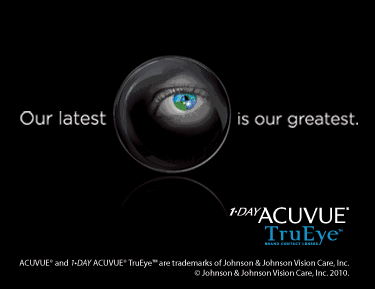|
Vistakon Announces Consumer Sweepstakes
Vistakon, Division of Johnson & Johnson Vision Care, Inc., announced the "New You" sweepstakes to give consumers the chance to have improved vision and better fitness in the New Year.
The "New You" Sweepstakes will run from January 1, 2011, through February 28, 2011. One Grand Prize winner will receive a one year supply of Acuvue Brand Contact Lenses along with a one year gym membership and five personal training sessions. Five First Prize winners will receive a one year's supply of Acuvue Brand Contact Lenses (when accompanied by a current, valid prescription; professional exam and fitting fees not included). Consumers can enter to win the "New You" sweepstakes and see official rules at www.eyes4living.com.
| -- ADVERTISEMENT -- |

|
InSite Vision Files IND for ISV-101 for Treatment of Dry Eye
InSite Vision Incorporated has filed an Investigational New Drug (IND) application for ISV-101 with the U.S. Food and Drug Administration (FDA). ISV-101 is InSite Vision's novel compound being developed to treat dry eye disease. ISV-101 combines a low dose of the non-steroidal anti-inflammatory (NSAID) bromfenac (Bromday/Xibrom marketed by ISTA Pharmaceuticals) with InSite Vision's proprietary DuraSite technology.
InSite Vision anticipates initiating a Phase 1/2 clinical trial in 2011 to evaluate the safety and efficacy of ISV-101 when administered twice daily to patients suffering from dry eye disease. The five-arm trial design will include three ISV-101 dose concentrations and comparisons against DuraSite and non-DuraSite (placebo) vehicles. Data from the Phase 1/2 study are expected to provide guidance on the ideal dose for ISV-101 and the design of a Phase 3 clinical program.
According to the company, its DuraSite polymer technology extends the duration of drug residence on the surface of the eye to facilitate better penetration, thereby potentially improving efficacy, safety and dosing of a given therapeutic. Initial data from clinical studies evaluating the combination of DuraSite with a higher dose of bromfenac have demonstrated a favorable safety profile. The company further states that, due to its distinct mode of action, ISV-101 is expected to act as a complimentary treatment to Restasis (marketed by Allergan, Inc.) for patients with dry eye disease.
Patients Receive Life Changing Gifts through SynergEyes Grants
Patients are receiving the gift of clear and comfortable vision thanks to the Sharing Vision Grant Program sponsored by SynergEyes, Inc. This program brings ClearKone hybrid contact lens technology to keratoconus patients who may otherwise not have access.
After refractive eye surgery in 2003, Cassidy Randle's initially good vision started deteriorating. She became almost blind in her left eye and had poor vision in the right. Unfortunately, none of the lenses she tried gave her comfort or vision back. It came to a point that she was unable to drive a car and her hopes of nursing school were fading.
After Dr. Gupta at the University of Texas Medial Branch (UTMB) Eye Center volunteered her time and provided a free fitting for her in ClearKone lenses, provided free by SynergEyes, Inc., Cassidy is now able to see again.
Currently, over 15 patients are enrolled in the program; receiving free lenses from SynergEyes and free fitting from participating eye care practitioners. One of these patients is Melanie LeMay who is working with Dr. Adam Gordon of the University of Alabama at Birmingham Eye Center to achieve clear vision for the first time in 17 years.
For more information on the Sharing Vision Grant Program, visit treatkeratoconus.com/sharing-vision-grant-program. Practitioners interested in prescribing ClearKone can visit www.FitSynergEyes.com.
Still Time Register for the Global Specialty Lens Symposium, January 27-30, 2011, Paris Hotel & Casino in Las Vegas

The 2011 Global Specialty Lens Symposium is rapidly approaching, but there is still time to register! With an expert international faculty and a CE-accredited agenda, the 2011 GSLS will include insightful presentations by experts in the field, hands-on demonstrations of cutting-edge products as well as scientific papers and posters. Look for more detailed information in Contact Lens Spectrum and online at www.GSLSymposium.com, where you may also register.
--ADVERTISING
Ocusoft Names Ward Executive Vice-President
Ocusoft, Inc. announced the appointment of Patrick Ward, RPh, MBA as its new Executive Vice President.
A pharmacist with over 15 years of international experience in business development, Ward's recently served as Vice President, Finance and Administration and co-founder of Aviara Pharmaceutical Research, a startup biopharmaceutical company, and formerly was Executive Director of Business Development of Encysive Pharmaceuticals.
Ward received his Bachelor of Science degree in Pharmacy from the University of Houston and his MBA from the University of St. Thomas' Cameron School of Business.
B+L Offers Crystalens iClear iPhone Application
Bausch + Lomb (B+L) announced that it is offering a free iPhone application, called Crystalens iClear, that will educate and entertain consumers about vision, cataracts and the B+L Crystalens product, the only FDA-approved accommodating intraocular lens.
The Crystalens iClear iPhone app will help users learn more about cataracts. In addition, they will be able to self-check their visual acuity and color vision and have some fun with the Crystalens iClear "Picture Hunt." The user will also be able to find a Crystalens surgeon by using "doc finder" on the application. The iPhone app is free and is available in iPhone App Stores.
This month at www.siliconehydrogels.org: Children and contact lenses, myopia progression, use of silicone hydrogels for patients with epidermolysis bullosa, and our synopsis of silicone hydrogels at the 2009 ARVO meeting.
|












